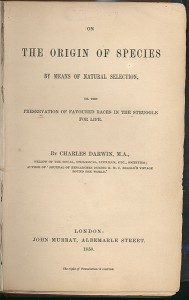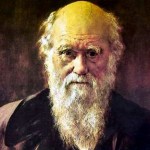Interestingly, the event was organized by an atheist organization. I am not a religious person and will always follow where the evidence takes me, but this event raised an important question in my mind: can one truly accept the facts of evolutionary theory and still be religious? And if one does tend to accept evolutionary theory and hold religous beliefs at the same time, which will they put first in an academic or research setting: science or faith? I have spoken to individuals in the past who hold faith so staunchly that they will disregard any evidence that conflicts with their religious beliefs no matter how solid or abundant the facts may be.
 When Charles Darwin published his famous book “On the Orgin of Species” in 1859 it shook the world and the foundation of all major religions. Many people saw his evolutionary theory as radical and conflicting with the religious teachings of Genesis; of course, it did conflict with the teachings and still does. Darwin and his famous book immediately received a harsh tongue lashing from his own Great Britain, as well as the rest of the European continent, United States, and the Roman Catholic Church. Nearly 150 years later the Church of England gave an official apology to Darwin for rejecting his theory on evolution and Pope John Paul II has decreed that evolution is consistent with the teachings of the Roman Catholic Church.
When Charles Darwin published his famous book “On the Orgin of Species” in 1859 it shook the world and the foundation of all major religions. Many people saw his evolutionary theory as radical and conflicting with the religious teachings of Genesis; of course, it did conflict with the teachings and still does. Darwin and his famous book immediately received a harsh tongue lashing from his own Great Britain, as well as the rest of the European continent, United States, and the Roman Catholic Church. Nearly 150 years later the Church of England gave an official apology to Darwin for rejecting his theory on evolution and Pope John Paul II has decreed that evolution is consistent with the teachings of the Roman Catholic Church.I will not get into debating about religious views here, but I do believe it is a great danger towards science and innovation if truth is not sought at all costs even if it takes us down a road we may not like. Can you believe even some of the greatest minds of our time such as Albert Einstein and Stephen Hawking, because of their anti-religious statements, have been savagely criticized as being theologically untrained and misunderstanding the nature of God? I am sure these legends or dare I say ‘Gods’ of science have the capacity for critical thinking and understanding!
There are many today who are trying to persuade schools to exclude evolution from the curriculum solely on religious beliefs. Think of the negative impact such a stance could have on innovating new technologies, drugs, and ideas. The study of any scientific field should have one goal at its core and that is to follow the evidence using scientific methods and make appropriate conclusions based on the facts at hand. If this is ever lost, science and innovation will lose ground that may never be able to be recovered.
Collection of Fossil Hominids:

Collection of Fossil Hominids
* (A) Pan troglodytes, chimpanzee, modern
* (B) Australopithecus africanus, STS 5, 2.6 My
* (C) Australopithecus africanus, STS 71, 2.5 My
* (D) Homo habilis, KNM-ER 1813, 1.9 My
* (E) Homo habilis, OH24, 1.8 My
* (F) Homo rudolfensis, KNM-ER 1470, 1.8 My
* (G) Homo erectus, Dmanisi cranium D2700, 1.75 My
* (H) Homo ergaster (early H. erectus), KNM-ER 3733, 1.75 My
* (I) Homo heidelbergensis, “Rhodesia man,” 300,000 – 125,000 y
* (J) Homo sapiens neanderthalensis, La Ferrassie 1, 70,000 y
* (K) Homo sapiens neanderthalensis, La Chappelle-aux-Saints, 60,000 y
* (L) Homo sapiens neanderthalensis, Le Moustier, 45,000 y
* (M) Homo sapiens sapiens, Cro-Magnon I, 30,000 y
* (N) Homo sapiens sapiens, modern




 Twitter
Twitter LinkedIn
LinkedIn Youtube
Youtube RSS
RSS